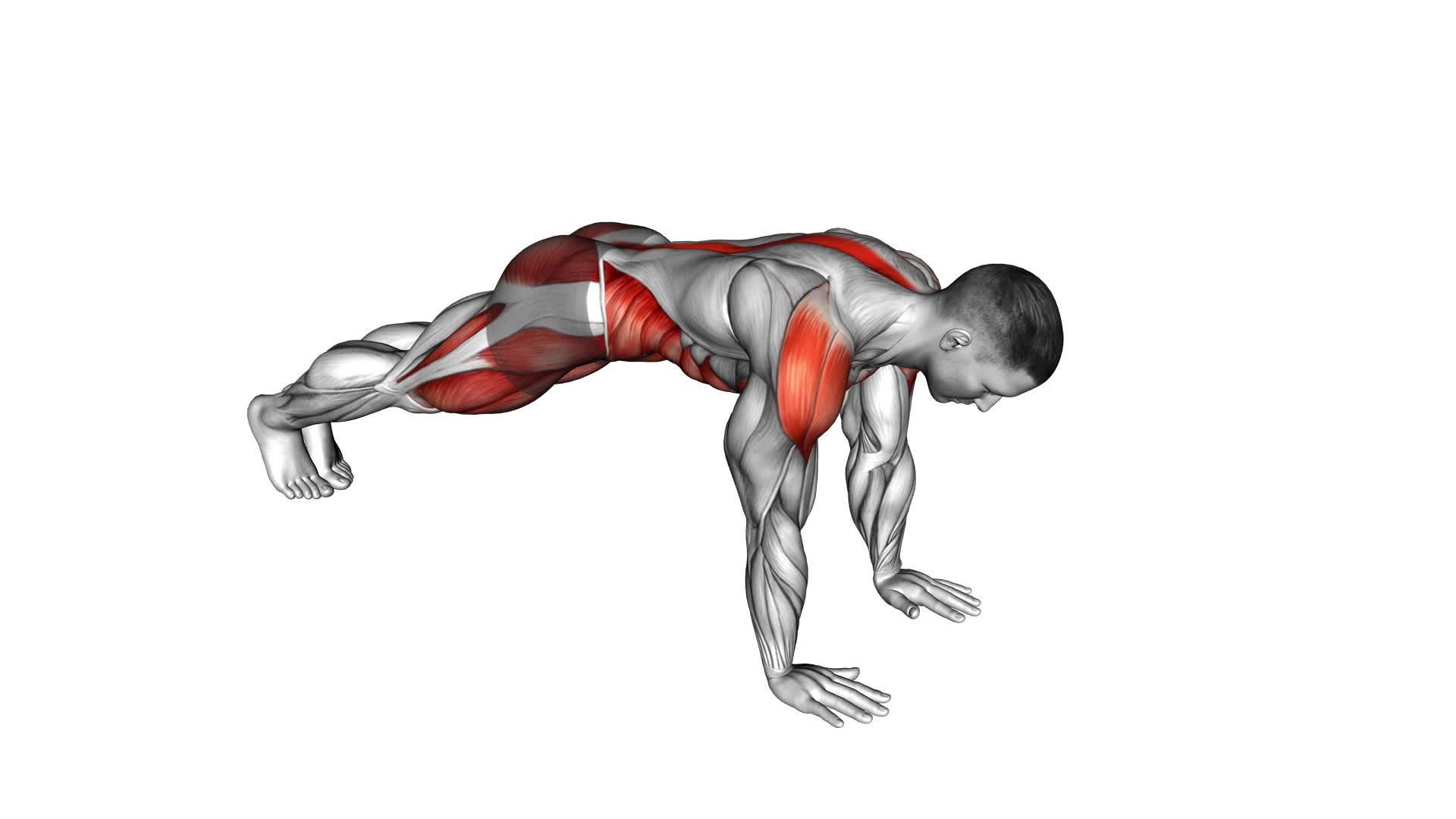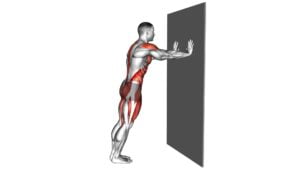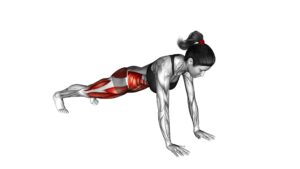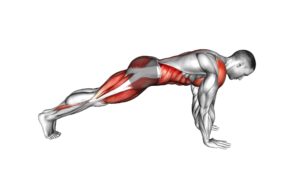Mountain Climber Cross – Video Exercise Guide & Tips

Looking to add a challenging exercise to your workout routine? Check out the Mountain Climber Cross!
Watch This Exercise Video
This dynamic movement targets your core, arms, and legs all at once. In this video exercise guide, you'll learn the proper form and technique, as well as common mistakes to avoid.
We'll also provide modifications for different fitness levels and tips for incorporating this exercise into your routine.
Get ready to amp up your fitness game with the Mountain Climber Cross!
Key Takeaways
- The Mountain Climber Cross targets multiple muscle groups simultaneously, including the core, arms, and legs.
- It improves cardiovascular endurance and aids in weight loss by burning calories.
- Proper form and technique include starting in a plank position, maintaining fluid and controlled movements, and engaging core muscles for stability.
- Common mistakes to avoid include letting hips sag or rise too high, not keeping arms directly under shoulders, and arching the lower back.
Benefits of the Mountain Climber Cross
- Experience five key benefits of the Mountain Climber Cross exercise.
The Mountain Climber Cross exercise offers numerous benefits for your body and overall fitness. By incorporating different mountain climber variations, you can target multiple muscle groups and enhance your workout routine. One of the primary benefits of the Mountain Climber Cross is its ability to activate various muscles simultaneously. This exercise engages your core, shoulders, chest, and legs, making it a full-body workout.
Muscle activation in the Mountain Climber Cross is particularly effective because it requires a high level of stability and coordination. As you perform the exercise, your core muscles work to maintain balance and control. Additionally, your shoulders and chest muscles are engaged as you bring your knees towards your opposite elbow, creating a cross-body movement that increases muscle activation and intensity.
Another benefit of the Mountain Climber Cross is its ability to improve cardiovascular endurance. This exercise is a dynamic and high-intensity movement that elevates your heart rate, promoting cardiovascular health. It also helps to improve agility and coordination, as you constantly switch between different positions and movements.
Furthermore, the Mountain Climber Cross is an efficient exercise for burning calories and aiding in weight loss. Its compound nature stimulates multiple muscle groups, increasing calorie expenditure and boosting your metabolism. This makes it an excellent addition to any weight loss or fitness program.
Lastly, the Mountain Climber Cross can enhance your core strength and stability. By engaging your abdominal muscles throughout the exercise, you can strengthen your core and improve your posture. This can have a positive impact on your overall fitness and help prevent injuries in other activities or sports.
Proper Form and Technique for the Exercise
To perform the Mountain Climber Cross exercise correctly, you need to focus on maintaining proper form and technique. This won't only maximize the effectiveness of the exercise but also prevent any potential injuries.
Here are three key points to keep in mind when performing the Mountain Climber Cross:
- Start in a plank position with your hands directly under your shoulders and your body forming a straight line from head to toe. Engage your core muscles to maintain stability throughout the exercise.
- As you bring one knee towards your opposite elbow, keep your hips low and your shoulders steady. This movement should be controlled and deliberate, with your core doing most of the work.
- Alternate between sides, bringing the opposite knee towards the opposite elbow. Remember to keep your movements fluid and avoid any jerking or bouncing motions.
Common Mistakes to Avoid During the Mountain Climber Cross
To perform the mountain climber cross correctly, it's important to maintain proper hip alignment for stability and arm placement for balance.
One common mistake to avoid is letting your hips sag or rise too high, as this can throw off your alignment and decrease the effectiveness of the exercise.
Additionally, make sure your arms are directly under your shoulders and your wrists are aligned with your shoulders to maintain balance and prevent strain on your wrists.
Hip Alignment for Stability
Ensure proper hip alignment for stability during the Mountain Climber Cross by avoiding common mistakes. Maintaining hip stability and proper alignment is crucial to prevent injuries and maximize the effectiveness of this exercise.
Here are three common mistakes to avoid:
- Arching your lower back: Keep your core engaged and your lower back flat to maintain a neutral spine. Avoid arching your back, as it can strain your hip flexors and lower back.
- Dropping your hips too low: Keep your hips in line with your shoulders to maintain stability. Avoid dropping your hips too low, as it can put excessive pressure on your lower back and lead to a loss of balance.
- Allowing your hips to rotate: Keep your hips squared and facing the ground throughout the exercise. Avoid rotating your hips, as it can lead to instability and compromise your form.
Arm Placement for Balance
To maintain balance during the Mountain Climber Cross, consistently position your arms correctly. Proper arm placement is essential for maintaining stability throughout the exercise. When starting the movement, ensure that your hands are directly under your shoulders, with your fingers spread wide for maximum support. Keep your elbows slightly bent, not locked, to avoid unnecessary strain on your joints.
As you engage in the cross-body movement, alternate bringing your knee towards your opposite elbow, it's crucial to maintain a strong and stable arm position. Avoid letting your shoulders sag or hunching forward, as this can throw off your balance and compromise the effectiveness of the exercise.
How to Modify the Exercise for Different Fitness Levels
How can you modify the Mountain Climber Cross exercise to accommodate different fitness levels?
The Mountain Climber Cross exercise can be modified to suit various intensity levels and fitness abilities. Here are three ways you can modify the exercise:
- Reduced Speed: If you're a beginner or have lower fitness levels, you can start by performing the Mountain Climber Cross at a slower pace. By slowing down the movement, you can focus on maintaining proper form and technique, gradually increasing your speed as you become more comfortable and stronger.
- Modified Range of Motion: For individuals with limited mobility or joint issues, you can modify the exercise by reducing the range of motion. Instead of bringing your knees all the way up to your chest, you can bring them halfway or even just lift your feet off the ground slightly. This modification allows you to still engage your core and lower body without putting excessive strain on your joints.
- Incorporating Support: If you find it challenging to maintain balance or stability during the exercise, you can modify it by using a support or prop. Placing your hands on an elevated surface, such as a bench or step, can help provide additional stability and support, making the exercise more accessible for those with balance issues or beginners.
Tips for Incorporating the Mountain Climber Cross Into Your Workout Routine
To incorporate the mountain climber cross into your workout routine effectively, it's important to engage your core muscles throughout the movement. By keeping your abs tight and pulling your belly button towards your spine, you can maximize the benefits of this exercise.
Additionally, focus on maintaining a steady pace and increasing your cardiovascular endurance levels by performing the mountain climber cross for longer durations or incorporating it into a high-intensity interval training (HIIT) circuit.
Engaging Core Muscles Effectively
To effectively engage your core muscles while incorporating the Mountain Climber Cross into your workout routine, focus on maintaining a strong and stable core throughout the exercise. This will ensure proper core activation and muscle engagement, maximizing the benefits of the exercise.
Here are three tips to help you engage your core effectively:
- Start by aligning your body in a plank position, with your hands directly under your shoulders and your toes on the ground.
- As you bring one knee towards your opposite elbow, engage your core by pulling your belly button towards your spine.
- Maintain a neutral spine throughout the exercise, avoiding any excessive arching or rounding of your back.
Increasing Cardiovascular Endurance Levels
To increase your cardiovascular endurance levels while incorporating the Mountain Climber Cross into your workout routine, focus on performing the exercise at a consistent and challenging pace throughout.
This exercise is an excellent choice for improving cardiovascular health and endurance training. The Mountain Climber Cross engages multiple muscle groups simultaneously, including your legs, core, and upper body, which increases your heart rate and challenges your cardiovascular system.
By maintaining a steady and intense pace during each repetition, you can effectively elevate your heart rate and sustain it for an extended period. This will improve your cardiovascular endurance over time.
As you progress, you can increase the speed or intensity of the exercise to further challenge your cardiovascular system.
Now, let's move on to recommended variations and advanced progressions for the Mountain Climber Cross.
Recommended Variations and Advanced Progressions for the Exercise
Try out different variations and advanced progressions to challenge yourself while doing the Mountain Climber Cross exercise. Here are some recommended modifications and advanced variations that you can incorporate into your routine:
- Elevated Mountain Climber Cross: Place your hands on an elevated surface, such as a bench or step, while performing the exercise. This will increase the difficulty by requiring more core stability and upper body strength.
- Weighted Mountain Climber Cross: Hold a dumbbell or kettlebell in each hand while performing the exercise. The added resistance will intensify the workout and engage your muscles even more.
- Single Leg Mountain Climber Cross: Lift one leg off the ground and perform the exercise with the other leg. This variation targets your glutes and hamstrings more intensely, while also challenging your balance and stability.
Remember to maintain proper form and control throughout the movements. Start with modifications that suit your fitness level and gradually progress to more advanced variations as you become stronger and more comfortable.
Frequently Asked Questions
How Many Calories Does the Mountain Climber Cross Exercise Burn?
The mountain climber cross exercise is a great way to burn calories and improve your fitness. It targets multiple muscle groups, including your core, arms, and legs. By engaging in this exercise, you can increase your heart rate and boost your metabolism, resulting in calorie burn.
The exact number of calories burned will vary depending on factors like your weight and intensity of the exercise. However, incorporating variations of the mountain climber cross exercise can add variety and challenge to your workouts.
Can the Mountain Climber Cross Exercise Help With Weight Loss?
The mountain climber cross exercise can be effective for weight loss as it engages multiple muscle groups and increases your heart rate. By incorporating this exercise into your routine, you can burn calories and improve your overall fitness.
There are various variations and modifications of the mountain climber cross exercise that can help you target different areas and increase the intensity. It's important to perform this exercise with proper form and gradually increase the difficulty to see the best results.
Is It Necessary to Warm up Before Performing the Mountain Climber Cross Exercise?
Before performing the mountain climber cross exercise, warming up is necessary to prevent injuries and maximize your workout. Warming up benefits include increased blood flow, improved flexibility, and enhanced performance.
If you don't have time for a full warm-up, you can try alternatives like dynamic stretches or light cardio exercises. However, keep in mind that a proper warm-up is important to prepare your body for the intensity of the mountain climber cross exercise.
How Often Should the Mountain Climber Cross Exercise Be Done for Optimal Results?
To achieve optimal results, it's important to incorporate mountain climber variations into your exercise routine. By doing this exercise regularly, you can experience the full benefits of the mountain climber exercise.
The frequency of performing the mountain climber cross exercise will depend on your fitness level and goals. It's recommended to consult with a fitness professional to determine the appropriate frequency for your specific needs.
Are There Any Specific Muscles Targeted by the Mountain Climber Cross Exercise?
The mountain climber cross exercise targets multiple muscles in your body. It engages your core muscles, including the rectus abdominis and obliques, to stabilize your torso. Additionally, it activates your hip flexors, glutes, and quadriceps as you bring your knees towards your chest.
The exercise also works your shoulders, triceps, and chest as you perform the cross movement. There are various variations of the mountain climber cross exercise that can further target specific muscle groups and increase the challenge.
Conclusion
In conclusion, the Mountain Climber Cross is a highly effective exercise that offers numerous benefits, including improved cardiovascular endurance, core strength, and overall body coordination.
By maintaining proper form and technique, and avoiding common mistakes, you can maximize the effectiveness of this exercise.
Additionally, modifying the exercise to suit different fitness levels and incorporating it into your workout routine can help you achieve your fitness goals.
Consider trying recommended variations and advanced progressions to challenge yourself and continue progressing in your fitness journey.

Author
Years ago, the spark of my life’s passion ignited in my mind the moment I stepped into the local gym for the first time. The inaugural bead of perspiration, the initial endeavor, the very first surge of endorphins, and a sense of pride that washed over me post-workout marked the beginning of my deep-seated interest in strength sports, fitness, and sports nutrition. This very curiosity blossomed rapidly into a profound fascination, propelling me to earn a Master’s degree in Physical Education from the Academy of Physical Education in Krakow, followed by a Sports Manager diploma from the Jagiellonian University. My journey of growth led me to gain more specialized qualifications, such as being a certified personal trainer with a focus on sports dietetics, a lifeguard, and an instructor for wellness and corrective gymnastics. Theoretical knowledge paired seamlessly with practical experience, reinforcing my belief that the transformation of individuals under my guidance was also a reflection of my personal growth. This belief holds true even today. Each day, I strive to push the boundaries and explore new realms. These realms gently elevate me to greater heights. The unique combination of passion for my field and the continuous quest for growth fuels my drive to break new ground.







